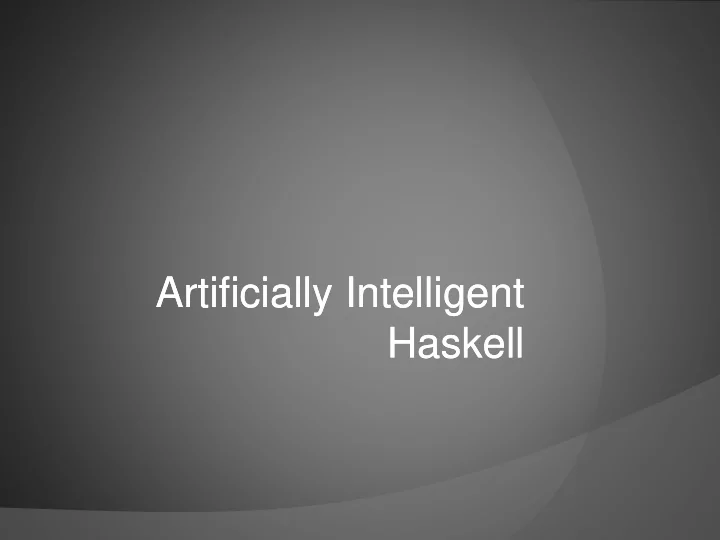

Artificially Artificially Intelligent Intelligent Haskell Haskell
Overview About Aetion What we do, and how we do it H o w F P h a s ( a n d h a s n ’ t ) h e l p e d
About Aetion Approach to AI based on widening regions of confidence based on explanatory necessity Most useful in domains with many overlapping possibilities or sparse data Currently supported by DoD contracts
The Challenges Frequent Changes Problem domains change New domains Changing approaches to existing domains Want to minimize code impact of changes
The First Solution Minimize work on things not directly relevant to current applications Fill in the gaps later.
The First Solution Minimize work on But: things not directly No general pattern for relevant to current extension applications Most problems Fill in the gaps later. required non-localized changes.
The Second Solution Find an abstraction and stick with it! Blueprint for Second-system Effect How did we make it work anyway?
F P ’ s c o n t r i b u t i o n s The types are cool The code is short The ideas are good
The Types are Cool Find many bugs before they happen Separating effectful and non-effectful code BUT: extensible records would be handy
The Code is Short Big advantage is not in writing, but in rewriting.
The Code is Short Big advantage is not in writing, but in rewriting. 10K lines of Haskell vs. 30K lines of Java
The Ideas are Good Monads, arrows, continuations, various combinator libraries, GADTs, even higher order functions. Makes over-generality easy.
The Result Three projects: Generalized data/change management (SNOWDRIFT) ○ Maintains relational view of data with constant time relation traversal ○ Provides priority-based process scheduling ○ Maintains tree of event handlers [Grust 1999] ○ Starts lightweight threads based on thrown events
Event Handlers Ideal: [ h |- confidence <|- (1 +) | i <- h |- linkedFrom Supports , i |- belief == Accepted ]
Event Handlers Ideal: [ h |- confidence <|- (1 +) | i <- h |- linkedFrom Supports , i |- belief == Accepted ] Actual, almost: [ h |- confidence <|- (1 +) | ModAttr i Belief _ Accepted = theEvent , h <- i |- linkedFrom Supports ]
The Result Three projects: Generalized data/change management Inference rules (WINTERMUTE) ○ Compositional constructers makeNamed “blah” >>= makeLocated (4,5) >>= makeExplainer >>= addMutable ○ Triggers propagate changes based on introduced relationships
The Result Three projects: Generalized data/change management Inference rules Application-specific hackery (PAWPRINTS) ○ Mostly pure Haskell ○ G r a d u a l l y a b s t r a c t e d a n d m o v e d “ u p ”
The Result Three projects: Generalized data/change management Inference rules Application-specific hackery All work pretty well!
R o g u e ’ s G a l l e r y Concurrency h |- attr <-- val But what about? h1 |- attr1 <-- val1 h2 |- attr2 <-- val2
R o g u e ’ s G a l l e r y Something more like: h1,h2 |- attr1 h1 <-- val1 attr2 h2 <-- val2 B u t t h i s d o e s n ’ t c o m p o s e
R o g u e ’ s G a l l e r y Records (Compositional Construction) data Entity e => Thing e = Thing Stuff e makeFoo >>= makeBar >>= makeThing >>= addMutable Then, we want uniform access to composed objects: Class ThingLike t where getStuff :: t -> Stuff setStuff :: Stuff -> t -> t
R o g u e ’ s G a l l e r y Records (continued) But then composition is hard: data Entity e => Thing e = Thing Stuff e instance (c e) => c (Entity e) where …
k Wh a t D i d n ’ t Wo r Client/Server Interface Serialization requirements forced some design decisions. Frequently pushing changes removed many possible uses of laziness
k Wh a t D i d n ’ t Wo r Client/Server Interface Serialization requirements forced some design decisions. Frequently pushing changes removed many possible uses of laziness B u t : t h a t ’ s m o s t l y o u r f a u l t . Wh a t ’ s t h e b e t t e r w a y ?
k Wh a t D i d n ’ t Wo r Management buy-in Maintenance and maturity of libraries Tools-related projects
What Can Work Better Libraries working together Cross-platform compatibility More tools development Debugging Profiling --- performance seems like a black art Programmer interest But: chicken and egg problem?
Thank you
Recommend
More recommend